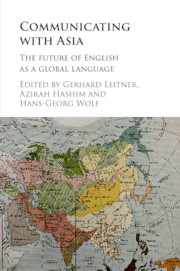Book contents
- Communicating with Asia
- Communicating with Asia
- Copyright page
- Contents
- Figures
- Tables
- Contributors
- Book part
- Communicating with Asia: introduction
- Part I English in selected regional and national habitats with a glance at the role of outward-bound communication needs
- 1 The development of English in Pakistan
- 2 English for Japan: in the cultural context of the East Asian Expanding Circle
- 3 Convergence and divergence of English in Malaysia and Singapore
- 4 Indian English prosody
- 5 Charting the endonormative stabilization of Singapore English
- 6 Arabic in contact with English and Malay in Malaysia
- 7 Preposition stranding and pied-piping in Philippine English: a corpus-based study
- 8 The Americanization of the phonology of Asian Englishes: evidence from Singapore
- 9 Postcolonial and learner Englishes in Southeast Asia: implications for international communication
- Part II Major other languages in Asia, their international status and impact on education
- Part III Wider perspectives
- Bibliography
- Index
3 - Convergence and divergence of English in Malaysia and Singapore
from Part I - English in selected regional and national habitats with a glance at the role of outward-bound communication needs
Published online by Cambridge University Press: 05 January 2016
- Communicating with Asia
- Communicating with Asia
- Copyright page
- Contents
- Figures
- Tables
- Contributors
- Book part
- Communicating with Asia: introduction
- Part I English in selected regional and national habitats with a glance at the role of outward-bound communication needs
- 1 The development of English in Pakistan
- 2 English for Japan: in the cultural context of the East Asian Expanding Circle
- 3 Convergence and divergence of English in Malaysia and Singapore
- 4 Indian English prosody
- 5 Charting the endonormative stabilization of Singapore English
- 6 Arabic in contact with English and Malay in Malaysia
- 7 Preposition stranding and pied-piping in Philippine English: a corpus-based study
- 8 The Americanization of the phonology of Asian Englishes: evidence from Singapore
- 9 Postcolonial and learner Englishes in Southeast Asia: implications for international communication
- Part II Major other languages in Asia, their international status and impact on education
- Part III Wider perspectives
- Bibliography
- Index
Summary
The different language policies adopted by Malaysia and Singapore in relation to the English language from the period of independence from British rule onwards signals the beginning of divergence. This has come about because of the distinct routes taken by both countries in their formulation of language policies, leading to differing linguistic landscapes in each country. Malaysia regarded English as a symbol of colonial rule and embraced Malay as the national language for nation-building. There were brief periods in recent times of assigning some prominence to the English language but this was accompanied by policy reversals and the concomitant de-prominence of English in relation to Malay. Singapore, on the other hand, took the pragmatic stance that English is both ethnically and culturally neutral and is therefore suitable to be the de facto official language and de jure working language of the country. The final section of this chapter explores, from a study of the latest acoustic research on selected phonological features of English in Singapore and Malaysia, whether the impact of these differing language policies has led to the development of two phonologically divergent varieties of English and highlights areas urgently needed for future research.
- Type
- Chapter
- Information
- Communicating with AsiaThe Future of English as a Global Language, pp. 43 - 55Publisher: Cambridge University PressPrint publication year: 2016
- 3
- Cited by

